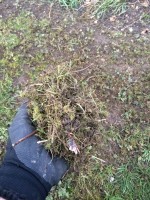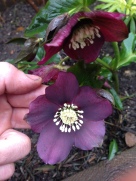 I often get asked if it is better to plant in the Autumn or Spring?
I often get asked if it is better to plant in the Autumn or Spring?
With all things, there are advantages and disadvantages to both…but I’ll share my view on this topic.
It simply depends on what is planned to be planted…
The immediate benefit about planting in the Autumn, is the fact that the plant establishes a good root system over the Winter and is settled in and ready for a boost of growth in Spring. Plants may appear dormant above ground during Winter, but they remain very active below ground. Although slower, there is still good root growth during the dormant season allowing the plant to settle in nicely.
The risk with Autumn planting is linked to the hardiness of the plants to be planted. They must be able to take whatever the Winter throws at them. Waterlogged soil, snow and freezing soil temperatures, all of which can be detrimental to the plants success. If they are hardy enough and tolerant of virtually any conditions, then it would be my advice to plant them in the Autumn.
My recommended plants for Autumn planting are:
 Dormant soft fruit and fruit trees; deciduous (non-evergreen) ornamental trees and shrubs; roses; Spring flowering bulbs; hardy evergreen shrubs and herbs as well as hardy perennials (plants which grow back each year) which can tolerate very wet soils. Turf laying is also recommended, as long as it is going down on soil with fairly good drainage. If your soil is prone to waterlogging, it may be more feasible to lay turf in the Spring.
Dormant soft fruit and fruit trees; deciduous (non-evergreen) ornamental trees and shrubs; roses; Spring flowering bulbs; hardy evergreen shrubs and herbs as well as hardy perennials (plants which grow back each year) which can tolerate very wet soils. Turf laying is also recommended, as long as it is going down on soil with fairly good drainage. If your soil is prone to waterlogging, it may be more feasible to lay turf in the Spring.
It’s the perennial plants which are prone to rotting and the slightly tender perennials and shrubs which are best left for Spring planting.
With air and soil temperatures on the rise in Spring, it becomes a more viable time to look at planting the more tender shrubs and perennials, but always be sure to keep an eye on the forecast for those unexpected frosty evenings which can wreak havoc to all the fresh new growth. Do not be tempted to start too early…the start of April around Easter weekend is traditionally the best time to get started with planting.
My recommended plants for Spring planting are:
 Most of the perennials apart from the very tender ones which are best left until after the frosts (usually beginning of June); any trees and shrubs; roses; Summer flowering bulbs; most herbs apart from the tender ones such as Basil, Parsley and most purple or soft leafed herbs which are best left until late May.
Most of the perennials apart from the very tender ones which are best left until after the frosts (usually beginning of June); any trees and shrubs; roses; Summer flowering bulbs; most herbs apart from the tender ones such as Basil, Parsley and most purple or soft leafed herbs which are best left until late May.
Vegetable gardening is best done in a protected environment until the risk of hard frosts have passed. Most allotment and vegetable gardeners would need to do a lot of protecting of their crops during the Winter months, but it’s generally the brassicas, leeks, shallots, onions and some garlic varieties which get planted in the Autumn and then more can progressively be planted as the risk of frosts pass after the end of May.
In summary, if a plant is tough as nails, plant it in Autumn and if the plant is more tender or requires more consistent conditions then Spring would be more ideal. If in doubt, plant in the Spring.
Happy gardening!

 1. Still ensure that all your tender plants are securely protected by fleece.
1. Still ensure that all your tender plants are securely protected by fleece.


